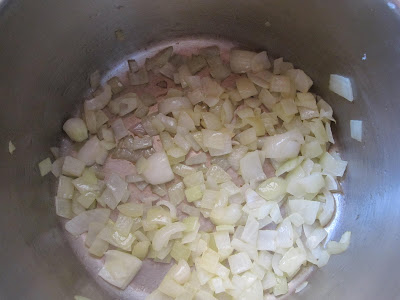The first recipe I learned to make came from the Dutch au pair next door, who was an exotic addition to our brand-new and homogenized Long Island suburb. This was the '60s, and the au pair was everything I was not: petite, curvy, sexy, and blonde. She was also seven years older than me, and I developed one of those undying crushes that only teenaged girls can have.
The relationship expanded when she married a friend of the family who lived in the Hamptons. I was her underage maid of honor. After that, I began to visit the young couple lots during the summers. I was her little sister for a long time, and she taught me to cook.
She was a classic teacher. She didn't measure; she didn't use recipes; she just knew how to be a good Dutch housewife. I call this recipe French peasant soup, because I once found a recipe much like it in a cookbook somewhere. But it's hers, and it has comforted me all my life.
GET A BIG POT
A big pot, with a heavy bottom. Dice an onion, or two (if they're small). Scrape the chopped onion off the cutting board into the pot, which has been heated and filled with enough oil to cover the bottom. At this point, I use olive oil for everything; I'm sure in the beginning I used "vegetable oil."
As the onions are gently sauteeing -- stir them occasionally -- peel or scrub three to five carrots and slice them. (Why peel an organic carrot?) Take a bunch of celery, trim off the browned cut ends of the stalks, remove any discolored leaves, and chop the whole bunch all at once, moving down the stalks till you have gone about halfway. Take all the pieces, dump them in a bowl of cold water to clean them; then pour the contents of the bowl through a strainer or colander.
By now, the onions may be beginning to brown; add the carrots and celery and stir, to slow down the cooking process. A little water at this point will also keep the onions from getting browner.
Peel five potatoes, more or less. I started with generic white potatoes, and I have never found a better substitute. (Yukon Gold are good; russets are bad.) Cut them into bigger pieces than dicing would accomplish; this provides substance to the soup. Throw them in the pot. And while you don't have to peel organic potatoes, white chunks look better.
Add one large (28-oz.) can of peeled plum tomatoes in juice. Then scoop up each tomato, one by one, with a big spoon, cut it in half the long way, and drop it back into the pot. This is part of the ritual for me, and I have no interest in accomplishing this more efficiently. As my blonde and groovy married friend explained, this helps the tomatoes to fall apart during the cooking process.
Fill the tomato can with cold water and add to the pot. Make sure the water level covers the vegetables at all times; as the soup simmers, you are going to be adding more water now and then. Turn up the heat until the soup begins to boil; then turn it down so it is bubbling, but barely.
Canned tomatoes often have added basil, a warming herb that is good for this recipe. The key, though, is thyme, so warm it's hot. Three good-sized pinches of dried thyme, ground between your fingers before it's dropped into the pot, gives a nice flavor to the tomato base. Fresh parsley. If you have an herb garden, basil, thyme, oregano, and marjoram are all great; and beyond that is your call. And add a bay leaf.
Simmer for two hours. What? Yes. It takes vegetables longer to soften in a broth made with canned tomatoes. Also, the longer you cook the tomatoes, the sweeter and richer they get.
I am typing up this new post as my soup cooks. I am checking the water level, stirring, amazed at how crisp the vegetables remain, but confident that gradually, but inevitably, the soup will soften into the tenderhearted fragrance of memory.
DISHING IT UP
This is a beautiful soup, red, green, white, gold. It's simple, clean and vegetal. To make it heftier, add chunks of jack or cheddar cheese, or slices of Swiss, to each individual serving. Or add a can of chickpeas to the pot, shortly before serving. I like to keep the original palette intact. I have been known to add sweet corn kernels, paired with sultry broccoli florets, in the last half hour of cooking. Salt and pepper to taste.






Great! Thanks for sharing, Sahaja!
ReplyDeleteXOXO
Sita
hey sahaja this was delicious thank you very very very very very much!!!!! YUM!!!!!!! Could you post the millet croquettes one too? :-) :-) :-)
ReplyDelete